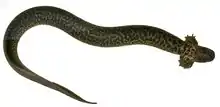Reticulated siren
The reticulated siren (Siren reticulata), also known as the leopard eel, is a species of aquatic salamander endemic to the southeastern United States, first formally described in 2018.[1][2] This cryptic salamander is known only from three localities in southern Alabama and the Florida panhandle and is one of the largest animals in the United States to be newly described in the past 100 years.[1][3]
| Reticulated siren | |
|---|---|
 | |
| Scientific classification | |
| Kingdom: | Animalia |
| Phylum: | Chordata |
| Class: | Amphibia |
| Order: | Urodela |
| Family: | Sirenidae |
| Genus: | Siren |
| Species: | S. reticulata |
| Binomial name | |
| Siren reticulata Graham, Kline, Steen, and Kelehear, 2018 | |
 | |
Description
The reticulated siren is one of the largest species of extant (living) salamanders worldwide, reaching up to 60 cm (2.0 ft) in total length, which rivals the hellbender of the Appalachian Mountains as both the largest amphibian in North America and the third largest salamander in the world.[1][3][4] It has a greenish grey, eel-like body, large external gills, and two small front legs.[1][5] The sides and belly are a lighter yellowish green. It has an average snout to vent length (SVL) of 33.4 cm (1.1 ft).[1][5]
Siren reticulata differs from other Siren species in its skin patterning: a patchwork of dark, leopard-like spots covering its back.[5] It also has a relatively smaller head and a longer tail.[1] Genetic analysis from mitochondrial and nuclear sequencing supported it as a separate species from Siren intermedia and Siren lacertina, and further suggested that additional species are yet to be discovered in this group.[1]
Almost nothing is known about its life history or ecology.[1][2] Its habitat includes wetlands within the longleaf pine ecosystem.[1]
Discovery
The first known reticulated siren was collected in 1970, in Baldwin County, Alabama, described by herpetologist Robert Hughes Mount as not conforming to the typical physical description of Siren lacertina.[1][6] It was not formally named at that time and was treated as somewhat of a legend, colloquially referred to as the "leopard eel".[1][2] Another sighting of numerous individuals was made in the 1990s by the herpetologist John Jensen, who reportedly sighted dozens of reticulated sirens and amphiumas moving across a road during a rainstorm near Florala, Alabama.[2]
In September 2009, American herpetologist David Steen was studying Nerodia (water snakes) and turtles at Eglin Air Force Base in Okaloosa County, Florida, when he captured a single specimen of Siren reticulata in a crayfish trap.[1][3][2] Additional trapping efforts between 2009 and 2014 were unsuccessful until three more sirens were found in June 2014 near Lake Jackson in Walton County, Florida.[1][2] The reticulated siren is one of the largest animals in the United States to be newly described in the past 100 years.[3]
Taxonomy
The leopard eel was formally described as Siren reticulata in December 2018.[1] The specific epithet reticulata refers to the reticulated (meaning network-like or patchwork) patterning typical of this species.[1] The authors of the 2018 paper coined the name reticulated siren as a "more appropriate formal common name", as it is neither a leopard nor an eel.[1][3] It is one of three extant species in the genus Siren.[7]
The holotype is a female captured in Walton County, Florida, measuring 39.7 cm (1.3 ft) from snout to vent and weighing 221 g (0.5 lb).[1] The type locality habitat was a shallow marsh vegetated with floating and emergent plants.[1]
References
- Graham, Sean P.; Kline, Richard; Steen, David A.; Kelehear, Crystal; Cimmaruta, Roberta (5 December 2018). "Description of an extant salamander from the Gulf Coastal Plain of North America: The Reticulated Siren, Siren reticulata". PLOS ONE. 13 (12): e0207460. doi:10.1371/journal.pone.0207460. PMC 6281224. PMID 30517124. Retrieved 5 December 2018.
- Graham, S. P.; Steen, D. "Song of the Siren -- The Story Behind How We Found and Described a Two-foot Long Amphibian New to Science". livingalongsidewild.com. Living Alongside Wild. Retrieved 6 December 2018.
- Bittel, Jason (5 December 2018). "New species of giant salamander discovered in Florida". nationalgeographic.com. National Geographic. Retrieved 5 December 2018.
- Platt, John R. "Swampy Thing: The Giant New Salamander Species Discovered in Florida and Alabama". Scientific American Blog Network. Retrieved 2018-12-19.
- Starr, Michelle (6 December 2018). "Scientists Have Captured a Giant, 'Mythical' Siren Species in Florida". sciencealert.com. Science Alert. Retrieved 6 December 2018.
- Mount, R. H. (1975). The reptiles and amphibians of Alabama. Auburn University, Agricultural Experiment Station.
- "Siren Österdam, 1766". research.amnh.org. Amphibian Species of the World. Retrieved 6 December 2018.
